News
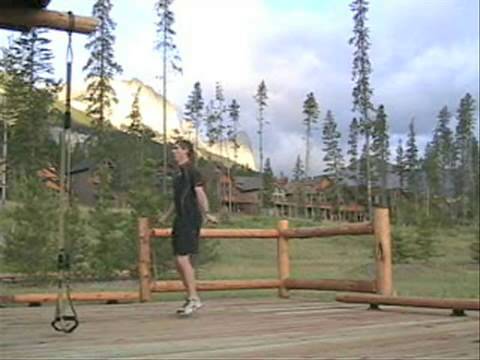
TRX Suspension Training and Jump Rope Fusion Workout
TRX Head of Training & Development Fraser Quelch often combines TRX Suspension Training and Rip Training with other tools to create dynamic, multimodality fusion workouts. In this video get a glimpse at a prototype jumprope and Suspension Training workout he created while developing the workouts for the "Ropes and Straps" DVD series with Buddy Lee.
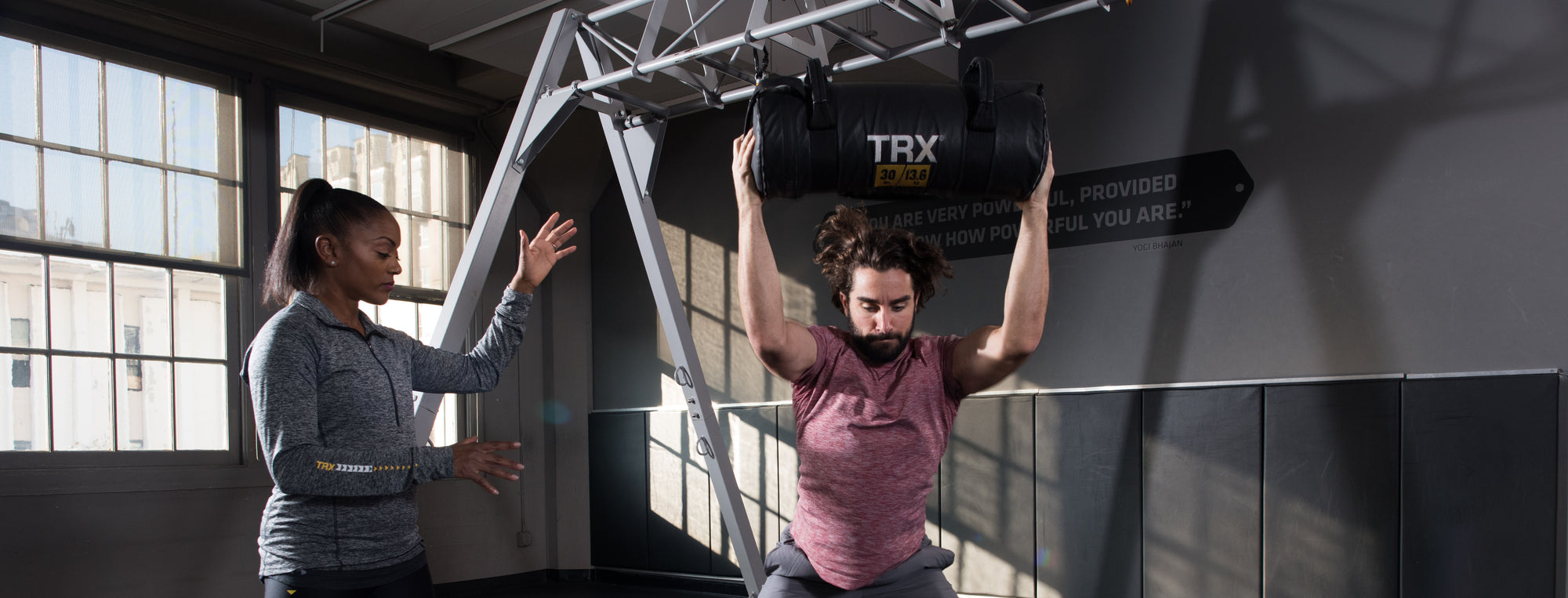
TRX Strap + Power Bag Workout
If you’ve never trained with Power Bags, you’re in for a treat. These cylindrical contraptions deliver smart, intense and powerful workouts that demand mental focus and full-body awareness. In other words, when you pick up one of these bad boys you better be firing on all cylinders (pun intended).
TRX Power Bags can be used on their own as a stand-alone workout or integrated with other functional training tools in a circuit-style training session (for instance in a bootcamp class). They are popular tools for training professional athletes, MMA fighters, and the Armed Services. Aka, they’re badass! Above all, Power Bags are a simple, effective, and fun tool that can be used just about anywhere.
TRX is excited to launch their new line of TRX Power Bags. Featuring a moisture-resistant cover, triple-stitched seams, and shape-retaining foam core, these bags come pre-filled with a fixed-weight (6 sizes from 10 lb - 60lbs) allowing for quick transitions and 7 different handles for easy and comfortable gripping.
Want to find the perfect power bag weight for your fitness level? Take our quick assessment quiz to get personalized equipment recommendations.
TAKE OUR TRAINING QUIZ
Other features include:
Sturdy, moisture-resistant material that’s resistant to tearing, with triple-stitched seams for added durability.
Surface material that wipes clean and won't absorb moisture.
Embroidered weight markers and logo that won’t wear off.
Volume increases as weight increases, enabling any user to find a bag that works for their size and skill level.
TRX STRAP + POWER BAG WORKOUT
ROUND 1:
TRX Squat Row:
Benefit: This exercise will help develop integrated core and upper body strength, as well as hip, ankle and shoulder mobility.
Exercise: Stand facing the Suspension Trainer with your feet facing forward, hip-width apart, holding the handles out in front of you. Brace your core and engage your glutes and hamstrings as though you are performing a plank while standing up.
Drop your hips down and back, while pushing your knees out, bringing your butt as close to your ankles as you can. When you get to the bottom, pull yourself forward with your hands while keeping your feet firmly planted on the ground. Let your weight rock back until you are back at the bottom of your squat position. Then drive your hips forward to return to your standing plank.
Repeat for 40 seconds aiming for 14 - 20 reps. Rest for 20 seconds.
TRX Forward Lunge with Chest Stretch:
Benefit: This exercise will help develop integrated core strength, as well as hip, ankle and shoulder mobility.
Exercise: Stand facing away from your anchor point. Begin with your feet close together, standing tall, arms and elbows straight, with hands reaching out in front of your chest. Take a lunge step forward and reach your arms out to the sides in a 'T' like shape. As you step forward, your back knee will bend, dropping towards the ground. Push off your front leg to return your feet back together, at the same time as bringing your hands together reaching out in front of you.
Repeat for 40 seconds aiming for 14 - 20 reps. Rest for 20 seconds.
Power Bag Mountain Climbers:
Benefit: This exercise will help with working on upper body stability and lower body mobility and conditioning as well as core strength.
Exercise: Place hands on Power Bag with the bag oriented wide holding a plank position with shoulders down and back, glutes engaged and core braced. Picking your right leg up, drive your right knee into your chest while maintaining a strong plank. Bring your right leg back to the starting position and pick your left foot up driving left knee into your chest, still maintaining a strong plank. Return left foot back to starting position and repeat this motion.
Repeat this for 40 seconds completing as many reps as possible. Rest for 20 seconds.
Runners Stretch:
Benefit: This exercise will help mobilize hips and ankles.
Exercise: Assume a plank position with core engaged, feet hip width apart and hands and wrists directly under shoulders. Step your right foot up placing your heel on the ground next to your right hand. Rotate your right arm up towards the ceiling, bring your eyes and head along to look up at your right hand. With an exhale, bring your right forearm as close to the ground as possible and begin to circle your hips working into your right hip. After a few circles going clockwise and counterclockwise, step your right foot back, assuming a plank position. Repeat on the left side.
Continue for 40 seconds aiming for 8-10 reps. Rest for 30 seconds.
Repeat Round 1. Increase the tempo on the first three exercises and allow heart rate to come back down on the final exercise.
ROUND 2:
Power Bag Deadlift:
Benefit: This exercise will help with mobility in the hips, as well as strength in your torso and upper body.
Exercise: Maintain a long spine and long legs, hinge with a slight bend in the knee while keeping back straight. Return to starting position squeezing glutes at the top. Repeat for 60 seconds aiming for 15 - 20 reps. Rest for 30 seconds.
TRX Chest Press:
Benefit: This exercise helps you build upper-body strength while providing an excellent core challenge.
Exercise: With straps fully lengthened, stand facing away from the anchor point with your hands holding the handles out in front of you. Brace your core and focus on holding a solid plank. Lower your chest towards your hands, focusing on moving your entire body together as if in plank position. Stop when your hands are in line with your chest.
Press yourself back up in one slow controlled movement, focus on keeping your knees, hips and shoulders in line the entire way up.
Repeat for 60 seconds aiming for 15 - 20 reps. Rest for 30 seconds.
Power Bag High-Row:
Benefit: This exercise will help build upper body strength in the shoulders, back and arms while stabilizing glutes and hamstrings.
Exercise: Stand straight up with legs hip-width apart and shoulders pulled down and back holding the power bag by the outside grips and resting on the thighs to begin. Put a soft bend in the knees and sit hips back slightly and bracing core. Squeeze shoulder blades up and together, lifting elbows to shoulder level until bag is in front of the chest and making sure there is no arch in the lower back. Slowly lower bag back down, keeping it as close to the body as possible until arms are fully extended.
Repeat for 60 seconds aiming for 15 - 20 reps. Rest for 30 seconds.
Power Bag Side-to-Side Push Up:
Benefit: This exercise will help build upper body strength with an uneven pressing surface to create instability in the press and challenge the typical move while stabilizing core strength.
Exercise: Place power bag vertically on the ground, next to you with the front of the bag lined up with your head assuming a plank position with your right hand on the bag and left hand on the floor. Lower your chest down towards the floor maintaining an active plank. As you push up from the bottom, transfer your left hand onto the bag and your right hand to the floor on the other side of the bag. Maintaining an active plank throughout the movement, begin to lower your chest to the floor to start the next push up.
Repeat this for 60 seconds aiming for 10-20 reps. Rest 30 seconds.
Repeat Round 2. Increase the tempo of each movement. Focus on full range of motion and rest as needed. Rest 1-2 minutes after second round.
For Coaches: To learn more about integrating TRX functional training tools into your workouts, check out our TRX Education courses here.
For Commercial Customers: To learn more about TRX Power Bags, contact your TRX Sales Representative - sales@trxtraining.com | 1-888-878-5348, opt 3.
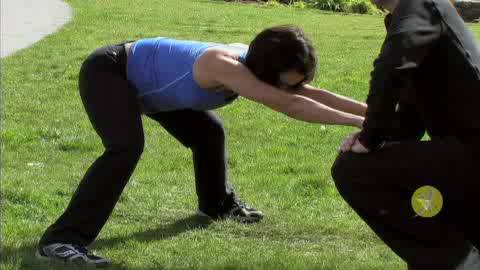
TRX Stretching: Flexibility Matters
If you workout, at some point, you’ve experienced pain due to inflexibility. “Pain is a common denominator that everyone understands. As a preventive measure, stretching will save you a huge amount of time, prevent injury and improve overall conditioning,” says Fraser Quelch.
Indeed, stretching on the TRX as part of a flexibility program can help to diminish many of the aches and pains you commonly experience as a consequence of physical activity.
Building greater flexibility using the TRX also:
Improves circulation
Improves range of motion
Improves posture
Decreases joint stiffness
Decreases muscle tension
Promotes awareness of body in space
Facilitates relaxation
Allows time for mental training, such as visualization
There are many different methods for increasing flexibility, but the TRX is particularly well suited to the task because it’s uniquely capable of facilitating a functional approach to improving flexibility. As this Flexibility Matters series continues, we’ll take a look at what that "functional flexibility" means and why it’s the best approach to improving flexibility. Until then check out the TRX Hip Hinge (Wide Stance) exercise below from our newly released TRX Essentials: Flexibility Program.
Fraser Quelch is Director of Programming and Education for TRX. He is also a featured fitness author and a competitive ironman triathlete.
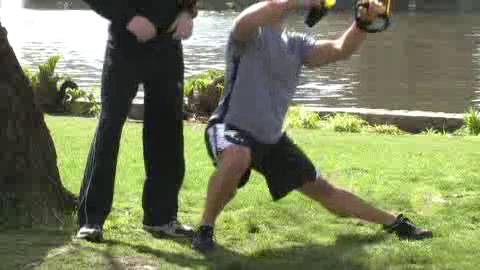
TRX Step Side Lunge
TRX Training
Fraser Quelch and Steve Katai demonstrate the TRX Step Side Lunge, an awesome move for strengthening the glutes, hamstrings, inner thighs and quadriceps.

TRX Stand Up Paddleboard Workout
Get ready to conquer the waves this summer with this TRX Stand Up Paddleboard (SUP) workout from the beaches of Santa Cruz, CA. Take our quick assessment quiz for a customized SUP-specific training plan to help you build stability and paddling strength.
TAKE OUR TRAINING QUIZ
In this video, Director of Rip Training Pete Holman pushes PaddleFit founder Brody Welte and professional SUP racer Willis Lindabury Brown through this sand-based Rip Trainer workout. PaddleFit is the No. 1 personal training company for SUP in the world, and Welte says that key fitness components for the sport include a strong core, balance and power. These functional Rip Training movements can help build the foundational muscles needed to make paddleboarders faster, stronger and more durable in the ocean.Get after Holman’s SUP workout with these three Rip Training moves. Perform each movement for 30 seconds with 30 seconds of rest between exercises. Repeat on the other side and perform the circuit three times. INSTRUCTIONS:Rip Paddleboard Row
Stand facing the anchor point in a squat stance. Hold the bar with your back hand palm up and your forward hand palm down.
Squat down and row the bar behind your leg.
Return to the start position and repeat.
Rip Hockey Slap Shot
Stand sideways to the anchor point in a squat stance. Hold the bar with your back hand palm down and your forward hand palm up.
Strike towards the ground by pulling the back hand towards the ribs and pushing the forward hand towards the ground. Pivot on the rear foot so you end up in a split squat stance.
Return to the start position and repeat.
Squat Row
Stand facing the anchor point in a squat stance. Hold the bar with both palms down
Squat down, rowing the bar towards your chest as you elevate.
Repeat.
For another TRX beach workout, check out the Surf Stronger TRX Suspension Training download.
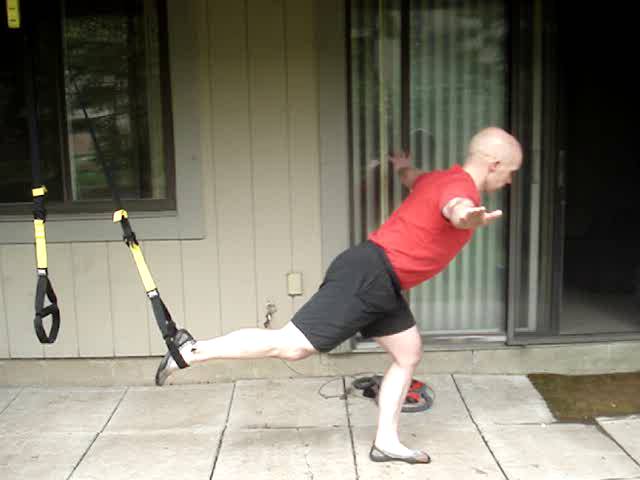
TRX Squat Variation Exercises
Here TRX Director of Programing and Education Fraser Quelch shows you a few excellent variations to the TRX Squat for an intense lower body and core workout.
A squat can be defined as any movement where one flexes through the hips, knees and ankle. While the squat appears to occur primarily in the sagittal plane of movement, the movement available at the spine, hips, knees and feet/ankle usually involves all three planes (sagittal, frontal and transverse) of movement. Want to find the perfect squat variations for your fitness level? Take our quick assessment quiz to get a personalized training plan that focuses on proper form and progression. The TRX can be used to tweak the squat movement pattern so that we can focus on all three planes of movement and promote more functional, proprioceptively enhanced joint and muscular function at the foot/ankle, knee, hip and spine, improving one's ability to move and function. Below are some squat variations using the TRX.
TAKE OUR TRAINING QUIZ
TRX Single Leg Squat to Crossing balance Lunge
This exercise combo below provides a challenging variation on the standard squat. Whether you use it as a warm up or part of your routine, this combo can inspire endless possibilities.
TRX Overhead Back Extension to TRX Overhead Squat
This video below takes two powerful movements, the TRX Overhead Back Extension and the TRX Overhead Squat, and combines them for one intense move that creates thoracic extension and improves postural strength.
This cool combo below, featuring the TRX Single Leg Squat and the TRX Crossing Balance Lunge, can be done slowly or powered through quickly, depending on your comfort level and focus. Pay special attention to form and function to maximize the benefit of combining these two great TRX exercises.
The number of foot positions is endless when it comes to squatting. You can adopt a side by side or staggered stance for the sagittal plane variations, wide stance or feet close together for frontal plane variations and internally rotated or externally rotated feet for the transverse plane variations. While these are some of the more common ways of altering foot position during the squat, the ability to combine some of these positions means there are actually multiple ways to modify a squat.
The same can be said for the arm/hand positions during a squat. Altering your arm or hand position during the exercise can allow us to focus the squat on a particular plane of movement and perhaps specific area of the body. Typically, overhead arm/hand positions are more likely to reduce hip/pelvis movement and focus the squat more on foot/ankle and knee structures. Arm/hand positions at waist to ground level will focus the squat more on the hip/pelvis structures.
Designing Your Training Program
When squatting with the TRX, look to incorporate the squat variations in your workout as either movement-based warm ups or specifically within a planned workout to focus on improving overall general squatting ability. These exercises are just a sample of the different ways you can use the TRX to improve your squatting ability.
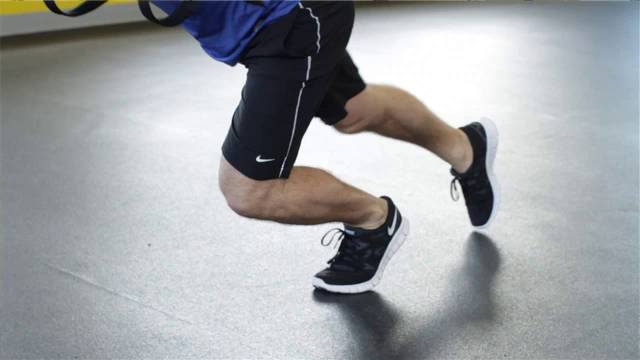
TRX Sprinter Start with Chris Frankel
To get the most out of your TRX Training you must master the basic movement before you earn your progression, add on intensity, and take an exercise to next level. Want to find the right progression path for your skill level? Take our quick assessment quiz to get a personalized training plan that builds from the fundamentals. In this video, TRX Director of Human Performance, Chris Frankel demonstrates this concept with the TRX Sprinter Start.
TAKE OUR TRAINING QUIZ
Start with a solid standing plank, lining up your knees, hips and shoulders brace your core and squeeze your glutes. This plank is the end range of motion for this exercise you will return to this plank at the end of every rep. Step back with one foot to get into the TRX Sprinter Start position and then bring this leg forward to meet the other foot and reset your plank. This is the standard, master it before you move on and nail that plank at the top on every rep.
Once you have the basic movement down you can progress this exercise by driving the knee of the working leg up to pause for a brief single leg plank at the top, or progress further and let the working leg drive into a small hop at the end range of motion.The goal is to maintain control and master your level of progression with perfect form before you layer intensity on top of it. This is how the concept of earning your progression applies to the TRX Sprinter Start.
Buy your TRX Suspension Trainer here.
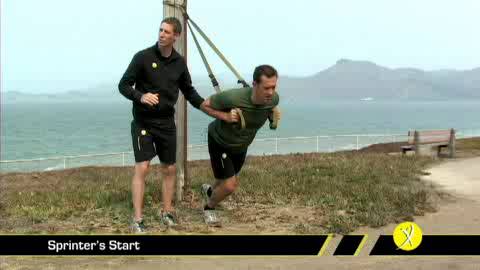
TRX Sprinter Start Exercise
This TRX exercise targets the muscular endurance and power of the quadriceps, hamstrings and gluteals, shown here with Fraser Quelch and TRX founder and CEO Randy Hetrick. It's also an excellent way to get your heart rate elevated in no time.
Fraser Quelch is Director of Training and Development for TRX. He is also a featured fitness author and a competitive Ironman triathlete.
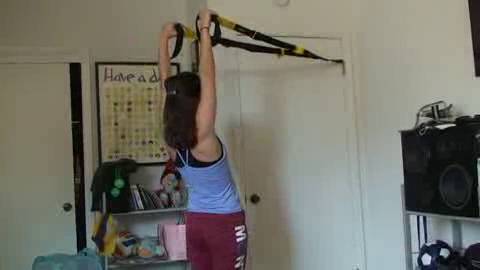
TRX Small Space Workout
Here is a workout you can do, no matter the size of your living space. Recent college grad and TRX marketing intern Jamie Adam (and a friend) demonstrates a TRX workout designed specifically for tight quarters, so now you have no excuse to skip a workout. Do one set of each of the following exercises two to three times a week... or whenever you can find time during study breaks.
Exercise
Reps
TRX Chest Press
10-15 reps
TRX Triceps Press
10-15 reps
TRX Biceps Curl
10-15 reps
TRX High Row
10-15 reps
TRX Single Leg Squat
10-15 reps (each leg)
TRX Y Deltoid Fly
8-10 reps
TRX W Deltoid Fly
8-10 reps
TRX Lunge
10-15 reps (each leg)
TRX Crunch
10-15 reps
TRX Hip Press
10-15 reps
NOTE: Enrollment in higher education institution optional. TRX Dorm Room Workout can be performed in any tight space, anywhere.
